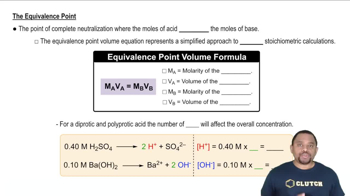Here are the essential concepts you must grasp in order to answer the question correctly.
Titration and Equivalence Point
Titration is a quantitative analytical method used to determine the concentration of a solute in a solution. The equivalence point occurs when the amount of titrant added is stoichiometrically equivalent to the amount of analyte in the solution. In this case, it is the point where all the HF has reacted with NaOH, allowing for the calculation of the required volume of NaOH to reach this point.
Recommended video:
Equivalence Point in Titration
Acid-Base Neutralization Reaction
An acid-base neutralization reaction involves the reaction between an acid and a base to produce water and a salt. In this scenario, HF (a weak acid) reacts with NaOH (a strong base) to form water and sodium fluoride. Understanding the stoichiometry of this reaction is essential for calculating the volume of NaOH needed to neutralize the HF.
Recommended video:
pH Calculation
pH is a measure of the acidity or basicity of a solution, defined as the negative logarithm of the hydrogen ion concentration. After the addition of a specific volume of NaOH, the pH can be calculated based on the resulting concentrations of the remaining acid and the produced salt. At the equivalence point, the pH will be determined by the hydrolysis of the salt formed, while beyond this point, the solution will be basic due to excess NaOH.
Recommended video:




